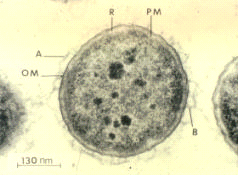Aeromonas salmonicida
Aeromonas salmonicida is a Gram-negative bacterium that is particularly known for causing furunculosis, a lethal disease in salmon and other salmonid fishes. This pathogen poses a significant threat to aquaculture and wild fish populations, leading to considerable economic losses in the fishing and aquaculture industries.
Characteristics[edit | edit source]
Aeromonas salmonicida is rod-shaped and possesses a number of virulence factors that enable it to infect its hosts. It is a mesophile, thriving best at moderate temperatures, which is significant in the context of its aquatic environment. The bacterium is also equipped with a type III secretion system, a mechanism that allows it to inject toxins directly into the host cells, facilitating infection and disease progression.
Pathogenesis[edit | edit source]
The disease process of furunculosis begins when Aeromonas salmonicida is ingested or enters through the skin of a fish. Once inside, it evades the host's immune response and proliferates, causing systemic infection. Symptoms of furunculosis include darkening of the skin, exophthalmos (bulging eyes), abdominal swelling, and the appearance of boils or furuncles on the body from which the disease gets its name. If left untreated, furunculosis can lead to high mortality rates in affected fish populations.
Transmission[edit | edit source]
Transmission of Aeromonas salmonicida can occur through direct contact between infected and healthy fish, or indirectly through contaminated water or equipment. The bacterium can survive for extended periods in water, making it a persistent threat in both natural and controlled aquatic environments.
Control and Prevention[edit | edit source]
Managing the spread of Aeromonas salmonicida involves a combination of biosecurity measures, such as quarantine of infected fish, disinfection of equipment, and maintenance of water quality. Vaccination has also emerged as an effective strategy for preventing furunculosis in fish populations, with several vaccines now available that can significantly reduce the incidence of the disease.
Economic Impact[edit | edit source]
The economic impact of Aeromonas salmonicida on the aquaculture industry is significant, with losses attributed to reduced fish quality and mortality. The disease not only affects the viability of fish farming operations but also has implications for wild fish stocks, potentially disrupting local ecosystems and biodiversity.
Research and Future Directions[edit | edit source]
Ongoing research into Aeromonas salmonicida is focused on understanding its pathogenesis, developing more effective vaccines, and identifying sustainable management practices to mitigate its impact. Advances in molecular biology and genomics are providing new insights into the bacterium's virulence mechanisms, offering hope for more targeted and effective control measures in the future.
Search WikiMD
Ad.Tired of being Overweight? Try W8MD's physician weight loss program.
Semaglutide (Ozempic / Wegovy and Tirzepatide (Mounjaro / Zepbound) available.
Advertise on WikiMD
|
WikiMD's Wellness Encyclopedia |
| Let Food Be Thy Medicine Medicine Thy Food - Hippocrates |
Translate this page: - East Asian
中文,
日本,
한국어,
South Asian
हिन्दी,
தமிழ்,
తెలుగు,
Urdu,
ಕನ್ನಡ,
Southeast Asian
Indonesian,
Vietnamese,
Thai,
မြန်မာဘာသာ,
বাংলা
European
español,
Deutsch,
français,
Greek,
português do Brasil,
polski,
română,
русский,
Nederlands,
norsk,
svenska,
suomi,
Italian
Middle Eastern & African
عربى,
Turkish,
Persian,
Hebrew,
Afrikaans,
isiZulu,
Kiswahili,
Other
Bulgarian,
Hungarian,
Czech,
Swedish,
മലയാളം,
मराठी,
ਪੰਜਾਬੀ,
ગુજરાતી,
Portuguese,
Ukrainian
Medical Disclaimer: WikiMD is not a substitute for professional medical advice. The information on WikiMD is provided as an information resource only, may be incorrect, outdated or misleading, and is not to be used or relied on for any diagnostic or treatment purposes. Please consult your health care provider before making any healthcare decisions or for guidance about a specific medical condition. WikiMD expressly disclaims responsibility, and shall have no liability, for any damages, loss, injury, or liability whatsoever suffered as a result of your reliance on the information contained in this site. By visiting this site you agree to the foregoing terms and conditions, which may from time to time be changed or supplemented by WikiMD. If you do not agree to the foregoing terms and conditions, you should not enter or use this site. See full disclaimer.
Credits:Most images are courtesy of Wikimedia commons, and templates, categories Wikipedia, licensed under CC BY SA or similar.
Contributors: Prab R. Tumpati, MD

